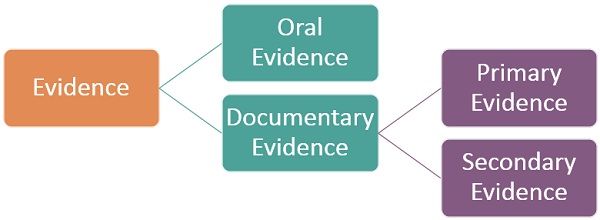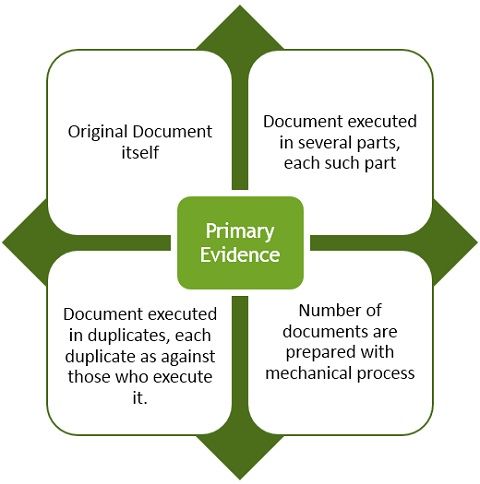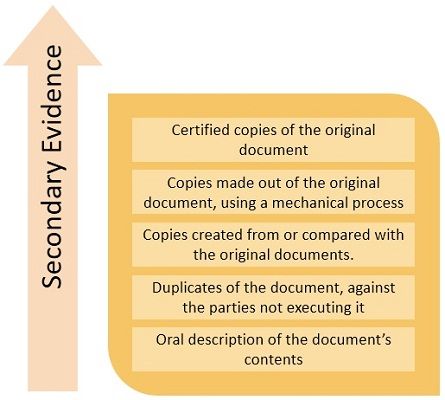 Primary Evidence is considered as the evidence of supreme value, in the eyes of law. On the contrary, Secondary Evidence is non-primary evidence which are used when the primary evidence cannot be produced.
Primary Evidence is considered as the evidence of supreme value, in the eyes of law. On the contrary, Secondary Evidence is non-primary evidence which are used when the primary evidence cannot be produced.
What is Evidence?
Evidence refers to proof of facts or genuine information that reflects the validity or authenticity of a belief or proposition. In the eyes of law, all the documents or statement which are permitted by the Court or made by the witnesses in front of the Court, with respect to the underlying cause, is an Evidence. It can be of two types, i.e. oral evidence and documentary evidence.
Further Documentary Evidences are of two kinds – Primary Evidence and Secondary Evidence
Golden Rule of Law of Evidence
“In all the cases, Best Evidence must be provided to the Court.”
What is a Document?
When a certain matter is expressed or outlined on any material using letters, figures, marks, or a combination of these, with the intention to use the same for recording that matter. For example Writing, Plan, Inscription, etc.
Section 3, of the Indian Evidences Act, 1872, states that the documents presented for the purpose of inspection to the Court, are Documentary Evidence.
Primary or Secondary Evidence is used to validate the contents of the document.
Content: Primary Evidence Vs Secondary Evidence
- Comparison Chart
- Definition
- Key Differences
- Example
- When Secondary Evidence can be produced?
- Conclusion
Comparison Chart
| Basis for Comparison | Primary Evidence | Secondary Evidence |
|---|---|---|
| Meaning | Primary Evidence is the first and legitimate copy of the document which is produced before the Court for inspection. | Secondary Evidence is the substitute but a less important copy of the document, which is produced when the primary evidence is not available. |
| Defined in | Section 62 of Indian Evidences Act, 1872 | Section 63 of Indian Evidences Act, 1872 |
| Nature of Source | Original or main source | Alternative source |
| General Rule | To provide primary evidence | Exception to the general rule |
| Prior Notice | Not required to be served to produce it before the Court | Must be served to produce it before the Court |
| Admissibility | The evidence is by itself admissible to the Court. | The evidence is admissible only if the primary evidence is not present. |
Definition of Primary Evidence
Primary Evidence, as the name suggests, refers to the documents in their authentic or standard form presented before the Court for the purpose of inspection, to check its validity.
It relies on the notion of Best Evidence. As per the notion, the document must be produced in front of the court in its original form, because then only the document is unmediated and highly reliable. It is considered the most reliable copy because it is free from any tampering, addition, or omission.
- Original Document which is produced in the court for inspection. For Example Contract between two parties A and B. The actual document containing the terms and conditions of the contract bearing signatures of both the parties will be primary evidence.
- Document executed (signed) in several parts, each such part. For example: In property agreements, each page of the document is signed, then each such page will be considered as primary evidence.
- Document executed in duplicates, each duplicate as against those who execute (sign) it. In cases when the contract or deed is printed in multiple copies so that all the parties can get a separate copy. It can be used as primary evidence against the party signing the document.
- Number of documents are prepared by the same mechanical process like painting, printing photography, etc, each is considered as the primary evidence of the contents of the rest. For example, Copies of partnership deed prepared to provide each partner containing the same content.
Also Read: Difference Between Confession and Admission
Definition of Secondary Evidence
Secondary Evidence is also proof of facts like primary evidence but is comparatively less important in nature.
These are provided in certain cases when the primary evidence is not present or cannot be produced before the Court in certain circumstances. This means that Secondary Evidence is the evidence presented as an alternative to the primary evidence, as stated in Section 65 of the Indian Evidences Act, 1872.
- Certified copies of the original document. Section 76 of the Indian Evidences Act, 1872 states that if the public document is under the custody of a government official, then such document should be provided on demand after the payment of the stipulated fees, to the person concerned. Once the copy is prepared from the original, the officer must specify at the bottom of the copy that – It is the true copy and add date in it.
- Copies made out of the original document, using a mechanical process. Document in whose preparation a uniform mechanical process is used. Here, the term mechanical process means printing, photocopy, or lithography confirming the correctness of the copy and copies examined in contrast with such copies. Further, under this clause, only those copies of secondary evidence are permissible which are certified if it is found certain that the original is possessed by another person.
Important: Copy of a copy is not permissible as a secondary evidence - Copies created from or compared with the original documents. When a copy of the original document is created using the exact words from the original.
- Duplicates of the document, against the parties not executing (signing) it. There are a number of situations in which contracts and deeds are printed in counterparts or say duplicates so that each party can have a separate copy of it. So, in such a case, the party not signing the document can use it against the one signing it, as secondary evidence.
- Oral description of the document’s contents provided by a person who has seen it himself or taken a read of such document.
What all is covered in secondary evidence?
It covers certified copies, copies made using a mechanical process, counterfoil of cheque or another document, photograph, photocopy, tape records, duplicates, unprobated will, age certificate, voter list, newspaper report, oral accounts, etc.
Also Read: Difference Between Detention and Arrest
Key Differences Between Primary and Secondary Evidence
As of now, we have completely understood the concept of these two. Now, we will move further to discuss the difference between Primary and Secondary Evidence:
- Primary Evidence implies the first-hand and most reliable copy of the document which is presented to the court for the purpose of inspection. Conversely, secondary evidence is less relevant evidence in comparison to Primary Evidence, which is used only when the primary evidence is unavailable for proof.
- Section 62 of the Indian Evidences Act, 1872 deals with primary evidence, whereas Section 63 of the Indian Evidences Act, 1872 deals with secondary evidence.
- The general rule is to provide the primary evidence to the court, whereas the provision of secondary evidence to the court is the exception to the general rule, permissible only in special circumstances, discussed in Section 65 of the Act.
- No prior notice is required to be served for producing primary evidence to the court. However, prior notice is required to be served for producing secondary evidence, for which rules are prescribed under Section 66, of the Act.
- When it comes to the source of evidence, primary evidence is the fundamental or original source while secondary evidence is the alternative source.
- While primary evidence is by itself acceptable to the court, secondary evidence is acceptable only when primary evidence is non-existent, unavailable, or cannot be provided.
Example
Suppose you go to a Photo Studio to get passport size photographs. All the copies received by you, in that case, acts as primary evidence as each photograph goes through the same mechanical process, whereas if you go to a studio to get the copy of a photograph clicked previously, then this will amount to secondary evidence.
When Secondary Evidence can be produced?
There are certain circumstances in which secondary evidence can be produced in place of primary evidence, provided certain conditions are satisfied:
- When the document is possessed by the person against whom it has to be proved, or by any person who is beyond reach, or any person who is legally obligated to produce the same but does not produce it, even after issuance of notice.
- When the existence of the original document, its condition and contents have been proven in written form by the one, against whom it has to be proved, or by his/her representative.
- In case the original document is destroyed or lost or the party providing the evidence is not able to produce it, due to any reason, except in case of negligence or default.
- In case the original document is of such kind which is difficult to move.
- When the original copy of the evidence is a public document
- When the original copy is a document whose certified copy is admissible.
- Where original copy comprises of multiple accounts and it cannot be examined easily.
Also Read: Difference Between Complaint and FIR
Conclusion
Obviously, on comparing the two, primary evidence will always have an upper hand over secondary evidence. In fact, the presentation of secondary evidence will only be admissible in case of non-availability of the primary evidence at the first place.








Leave a Reply